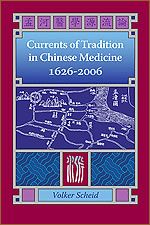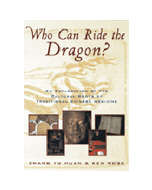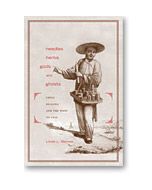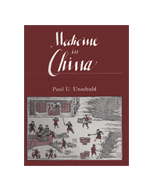We use cookies to make your experience better. To comply with the new e-Privacy directive, we need to ask for your consent to set the cookies. Learn more.
Currents of Tradition in Chinese Medicine 1626 - 2006
In 1626, a young man named Fei Shangyou moved his family to Menghe, a small town in the Yangzi delta of China. According to family legend, he abandoned his career as a scholar and began working as a physician. In doing so, he founded a medical lineage that continues to the present day. This book describes the development, flourishing, and decline of this lineage and its many branches, as well as that of the other medical lineages and families with which it merged over time to form the “current of Menghe learning” (Menghe xuepai).
This current and its offshoots produced some of the most influential physicians in the Chinese medical tradition during the 19th and 20th centuries. Menghe physicians, their disciples and students treated emperors, imperial mandarins, Nationalist Party generals, leading figures in the Communist Party, affluent businessmen, and influential artists.
In late imperial China, Menghe medicine was a self-conscious attempt to unite diverse strands of medical learning into one integrated tradition centered on ancient principles of practice. In Republican Shanghai, Menghe physicians and their students were at the forefront of medical modernization, establishing schools, professional associations, and journals that became models for others to follow. During the 1950s and 1960s, the heirs of Menghe medicine were key players in creating the institutional framework for contemporary Chinese medicine. Their students are now practicing all over the world, shaping Chinese medicine in Los Angeles, New York, Oxford, Mallorca, and Berlin.
The history of the Menghe current is relevant to anyone interested in the development of Chinese medicine in late imperial and modern China. This book traces Chinese medical history along the currents created by generations of physicians linked to each other by a shared heritage of learning, by descent and kinship, by sentiments of native place as well as nationalist fervor, by personal rivalries and economic competition, by the struggle for the survival of tradition and glorious visions of a new global medicine.
On the level of both theory and practice, this history marks a departure from the focus on texts and ideas that has dominated Western engagement with Chinese medicine to date. Its goal is to locate medicine within the concrete lives of physicians and their patients, restoring an agency to their actions that easily gets lost in our search for the forces or structures that shape historical process. To this end, the author interweaves social history and medical case studies, ethnography and biography to narrate a story of Chinese medicine that is very different from any that has been told before.
"A superb study that speaks both to medical historians and anthropologists, and to the increasingly globalized communities of contemporary practitioners of Chinese medicine. Scheid’s work is unique in integrating a subtle understanding of historical multiplicity with insights based on his own clinical experience."
—Charlotte Furth, Professor of Chinese History, University of Southern California
"At the beginning of this astonishing book, Volker Scheid raises the most fundamental, most daunting questions in medical history: First, what is a medical tradition? What makes us see stable structures in a world where the only constant rule is change? What maintains them in a society where medicine was not an organized profession? What gives birth to such a tradition? How does it die? . . . Currents of Tradition in Chinese Medicine grapples on every page with these practically unexamined questions, and develops as convincing a set of answers as we are likely to have for a long time."
—From the Foreword by Nathan Sivin, Professor of Chinese Culture and the History of Science, University of Pennsylvania
"Combines sophisticated arguments about social processes and processes of remembering with the specific histories of individual physicians and their colleagues, patients, aspirations, and clinical styles. . . . Historians, anthropologists, practitioners and patients will all find gems that please them in this remarkable new contribution to the field."
—Marta Hanson, Assistant Professor, Department of History of Medicine, Johns Hopkins University
"This book fills an important gap. There are few works available on the history of Chinese medicine, the development of the Chinese medical tradition and the transmission of medical knowledge in China. It is an essential point of reference for any practitioner of Chinese medicine who wants to reach beyond the narrow circle of knowledge acquired in the course of gaining a professional qualification, and who wants at least to try to connect with his or her ‘ancestors.’ It is also relevant because it reveals the fragility of the Chinese medical tradition, something we might not have suspected or thought about. It is as fragile as memory itself. And thus we have the responsibility of keeping it alive."
—Olga Fedina, European Journal of Oriental Medicine
"Those interested in the history of the multifaceted tradition of Chinese medicine will find this an intriguing look behind the veil of current orthodoxy to a practice where, for example, self-cultivation could form the basis for clinical efficacy. An inspiring book."
—Steve Clavey, author, Fluid Physiology and Pathology in Traditional Chinese Medicine
"As a student of Qin Bowei, and therefore part of the Menghe tradition myself, I wholeheartedly recommend this text as an introduction to the depth of the Chinese medical tradition."
—Wu Boping, Professor, China Academy of Chinese Medical Sciences.
CURRENTS OF TRADITION IN CHINESE MEDICINE: 1626‑2006
by Volker Scheid, Eastland Press, hardback, 564 pages
While sitting in the waiting room of a colleague in Munich, this time as a patient, I struck up conversation with two middle‑aged Damen ‑ sisters it turned out ‑ who had flown in that morning from Berlin. They made this journey once a month, they said, to have their pulses taken and their tongues looked at, receive acupuncture treatment and take their prescriptions to a local pharmacy. The herbs would be ready to be picked up by the time they had finished eating their Weißwurst at the Franziskaner restaurant. After a leisurely promenade on the elegant Maximilianstrasse and a peek inside one of the splendid new art galleries, they would board the evening flight home to Berlin. Had they perhaps considered seeing any of the famous Chinese doctors in Berlin, I asked. Indeed, but they had been disappointed with the consultation and treatments; the Munich physicians were infinitely superior! Did I know that many years ago, 1950 it was, a German scholar had founded an association to study and promote real, traditional Chinese medicine? Was I aware that the doctor we were all waiting to see, the most famous student of the illustrious scholar, was known for treating the root of his patients’ problems and not just treating symptoms? Also a respected teacher and the president of a medical association? They confided that they were here on the recommendation of a member of the Bundestag in Berlin, who had been cured many years ago by this doctor. They persisted: was I drinking my herbs? Did I feel the benefit of the decoction? They liked this doctor’s prescriptions very much; the decoctions were not too bitter, they were easily digested, and – they assured me ‑ did not harm their delicate constitutions. And the excellent pharmacy had been filling out Chinese herbal prescriptions for more than 30 years. Munich had a tradition for Chinese medicine, something we had to respect, nicht wahr? Impressed by these women’s devotion to my colleague, I was escorted by an assistant into one of the consultation rooms. The room, tastefully appointed and full of light, displayed all the trappings of a scholar‑physician: copies of one of his recently‑authored books were piled on the floor next to the desk, a manuscript sent for review marked “urgent” lay untouched in its original wrapping nearby; a few gifts from grateful patients (objets d’art, a small mixed‑media sculpture depicting the doctor treating a patient) were scattered among the bookshelves; on the desk, casually placed to one side, a fax from a famous stage actor assuring that two complementary tickets for that night’s sold out performance would be held at the box office; a plaque commemorating a visit from a Bulgarian TCM delegation and a red banner with gold Chinese characters proclaiming friendship between Germany and China hung in a corner. I couldn’t wait to speak to the great man about my ailment. In 400 years or so, descendants of the doctor’s lineage will be researching this type of medical encounters, thumbing through a tattered copy of his formula book and writing the equivalent of Currents of Tradition in Chinese Medicine: 1626‑2006. In it, they will draw parallels between the development and spread of specific styles of Chinese medicine in both countries and in both millenia. While reading the first part of Volker Scheid’s scholarly documentation of the famous families or lineages of Menghe doctors, I was struck by the similarities between Scheid’s scholar‑physician hero Fei Boxiong (1800‑1879) and my Munich therapist ‑ both built up their practices thanks to one or two “star” patients (the Empress dowager) who recommend the practice to gentry clientele in distant places (to the village of Menghe from Beijing instead of Berlin), both recognized the necessity of “light” prescriptions for patients with weak constitutions (wealthy patients who did neither physical work nor exercise), they inherited medical knowledge from a teacher‑scholar (members of the Fei family), published books (Yifang lun) and were important members of a medical association (Hanlin Academy). In the second part of the book (“Republican China: Native Place, National Essence and Divergent Modernities”) I found additional similarities between Ding Ganren, another prominent Menghe physician whom Scheid credits with the modernisation of Chinese medicine, and my Munich colleague. Ding Ganren (1864‑1926), took the Menghe medical tradition out of the backwater hamlet in Northern Zhejiang province and became a highly successful medical entrepreneur in early 20th century Shanghai. Like my Munich colleague, Ding’s business efforts were supported by a pharmacist who marketed “Ding family‑owned secret prescriptions”. Ding Ganren was also an inspiring teacher, who developed a modern curriculum and created uniform teaching standards. A wily politician, Ding used his lineage’s network to place his practice and school in an advantageous position. Scheid recounts recent meetings with descendants ‑ family members and students ‑ of the Ding lineage and describes how they have come to terms with the decline of the Menghe tradition. Scheid’s vivid descriptions of the in‑fighting among the various Chinese medical factions which co‑existed in Republican China and their struggle against proponents of conventional Western medicine are painfully reminiscent of struggles which continue in Europe (and elsewhere) to this day. In Chapter 12 (“The Institutionalization of Chinese Medicine and its Discontents”) Scheid addresses this thorny issue and presents some of the Menghe heirs as chief players in the scramble for hegemony during the early days of Mao Zedong’s rule. He also includes a biography of the modern physician and educator Qin Bowei who was able to assimilate Western medical concepts into his Chinese medical practice; an inspiration for contemporary physicians attempting this balancing act. The above are just a few of the many fascinating biographies and anecdotes included in this scholarly work. This alone would have been a remarkable tour de force of anthropological fieldwork and historical research. However, as in his 2002 publication - Chinese Medicine in Contemporary China: Plurality and Synthesis - Scheid has gone beyond the merely descriptive, and throughout the first two sections, but most clearly in the third part – “Contemporary China: Inheriting, Remembering and Reconfiguring Tradition in a Modern State”‑ he presents the already‑dazzled reader with a brilliant analysis of a multitude of important subjects in Chinese medicine. These have been cleverly woven into the tapestry of the narrative of the Menghe doctors throughout the centuries and include topics such as: what is a lineage; what is tradition; the role of the scholar‑physician in society; the art of medicine; how li, the Neo‑Confucian concept of principle, ideal or axiom, was transformed from a private virtue to a shared communal effort and how the disorderly strands of a myriad lineages of Chinese medicine were neatly packaged and exported as the product we now know as TCM. Currents of Tradition in Chinese Medicine is a remarkable book which requires attentive reading and a good memory; the glut of unfamiliar personal and place names and the intertwining genealogies may be bewildering. However, readers will find that once they venture one toe into the sparkling waters of the book, they will be swept away by Volker Scheid’s elegant writing style and into the compelling narrative of how the Menghe current grew to a mighty river which shaped the landscape of Chinese medicine, only to wither into a tired rivulet a few decades afterwards. This book, lovingly designed and printed by Eastland Press, includes many early 20th century photographs of China and portraits of the Menghe doctors. Looking at these pictures only increases the poignancy of the loss of this medical tradition.
Velia Wortman,Furth, Germany
| Summary | In 1626, a young man named Fei Shangyou moved his family to Menghe, a small town in the Yangzi delta of China. According to family legend, he abandoned his career as a scholar and began working as a physician. In doing so, he founded a medical lineage that continues to the present day. This book describes the development, flourishing, and decline of this lineage and its many branches, as well as that of the other medical lineages and families with which it merged over time to form the “current of Menghe learning” (Menghe xuepai). This current and its offshoots produced some of the most influential physicians in the Chinese medical tradition during the 19th and 20th centuries. Menghe physicians, their disciples and students treated emperors, imperial mandarins, Nationalist Party generals, leading figures in the Communist Party, affluent businessmen, and influential artists. In late imperial China, Menghe medicine was a self-conscious attempt to unite diverse strands of medical learning into one integrated tradition centered on ancient principles of practice. In Republican Shanghai, Menghe physicians and their students were at the forefront of medical modernization, establishing schools, professional associations, and journals that became models for others to follow. During the 1950s and 1960s, the heirs of Menghe medicine were key players in creating the institutional framework for contemporary Chinese medicine. Their students are now practicing all over the world, shaping Chinese medicine in Los Angeles, New York, Oxford, Mallorca, and Berlin. The history of the Menghe current is relevant to anyone interested in the development of Chinese medicine in late imperial and modern China. This book traces Chinese medical history along the currents created by generations of physicians linked to each other by a shared heritage of learning, by descent and kinship, by sentiments of native place as well as nationalist fervor, by personal rivalries and economic competition, by the struggle for the survival of tradition and glorious visions of a new global medicine. On the level of both theory and practice, this history marks a departure from the focus on texts and ideas that has dominated Western engagement with Chinese medicine to date. Its goal is to locate medicine within the concrete lives of physicians and their patients, restoring an agency to their actions that easily gets lost in our search for the forces or structures that shape historical process. To this end, the author interweaves social history and medical case studies, ethnography and biography to narrate a story of Chinese medicine that is very different from any that has been told before. |
|---|---|
| Author | Dr Volker Scheid |
| Publication Date | 1 Jan 1970 |
| Publisher | Eastland Press |
| Number of Pages | 564 |
| Book Format | Softback |
* Orders shipped outside of Europe are eligible for VAT relief and will not be charged VAT.






